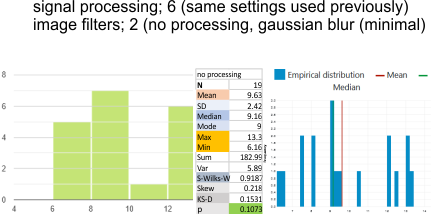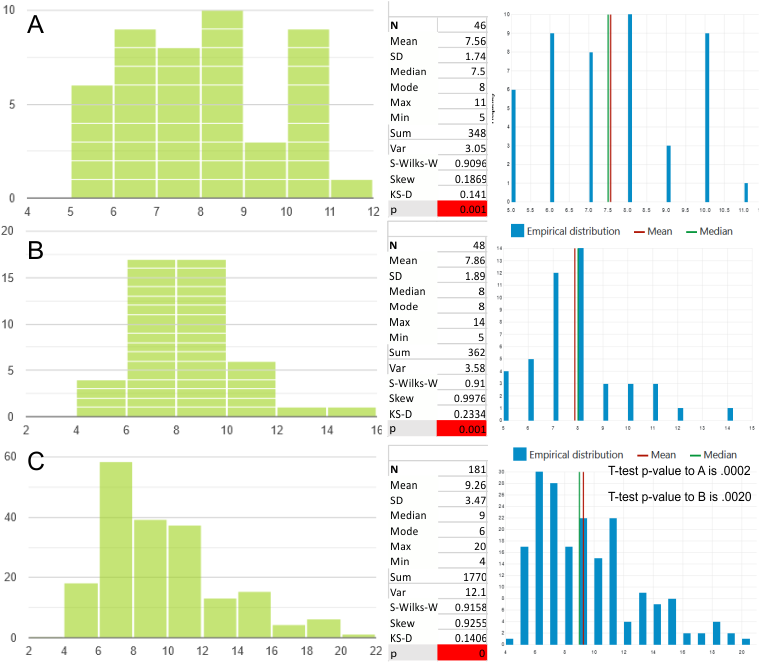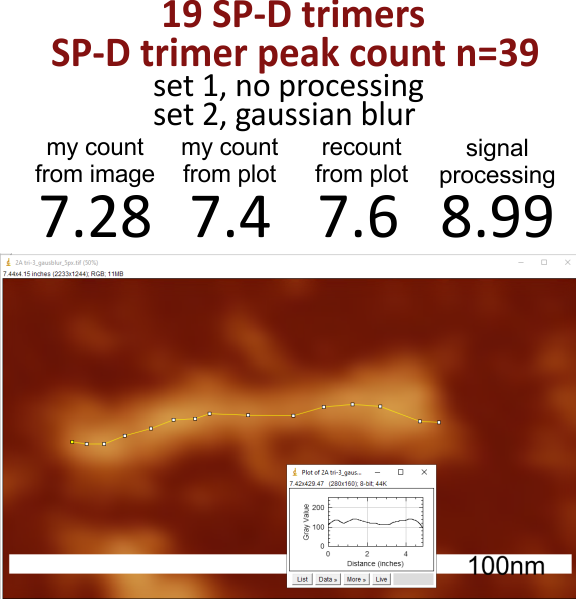The image below is the result of a test of whether the image filters available in various free and paid programs made much of a difference in the detection of brightness peaks (incidence, height, valley, width). The answer, it seemed to me, was that a rational application of many filters did very little to change the raw image, and even after radical filtering, such as “posterizing” (red and yellow images below) conveyed the same SP-D structure.
Programs used to score image filtering ranged from “paid” Photoshop 2021, CorelDRAW 19 (also with the built-in raster editing program of the latter), older purchased Photoshop (6) and CorelDRAW (x5)(also with a raster editing program), and “free” programs with image filters such as ImageJ, Gwyddion, Inkscape, GIMP, and Paint, as well as several image filtering options in “free” Octave. Below are samples of all of the above for checked uniformity in their individual application of filtering algorithms, using a single dodecamer as a test photo.
That photo was derived from a screen print from Arroyo, et al. Easily identified are the N term junction of the four trimers (bright center*), just lateral to that the glycosylation site (each of the four trimers shows some degree of brightness*, there are at lest three bright peaks found lateral to the glycosylation peak (as of now, not named and with no known function but highly repeatable peaks are found in literally hundreds of plots of dodecamers and separately as trimers), and on the ends of the trimers, the carbohydrate recognition domains*.. which typically have several peaks combined (which is consistent with that domain being modeled on RCSB as three flexible and floppy globular formations. Just before the CRD domain peaks, is the neck domain, which may or not be visible as a “peak” depending upon how the molecule is arranged during processing. (nb, the * denotes known peaks).
One image filter (Gwyddion, image presentation filter) (center image bottom row) probably does the best job of maximizing the appearance of bright spots (peaks).
The three posterized yellow images were used to test (using the same settings) whether various programs would produce identical results, which actually did appear to be true. The reasoning behind this test was that the old Adobe Photoshop 6, well outdated, but free and easy to use, was compared with the same filters in the paid version of Photoshop 2021. Similarly, CorelDRAW x5, also old, was no different in application of imaging filters with the same settings as CorelDRAW 19. This opens opportunity for reliable image filtering to be had from existing, familiar and free programs with easy to use formats.
Image Filters and programs (out of the sample of 100 in the image below) that will continue to be used for peak finding are:
1: no processing (as a control)
2: Gaussian blur (2px, 5px (10px in one extremely pixelated image)(CorelDRAW, Photoshop)
3: Limit range 100-255 (Gwyddion)
4: Gaussian blur plus 250 highpass (Photoshop)
5: Gaussian blur plus 50-50-50 unsharp mask (Photoshop)
6: Median filter 10px (Photoshop)
This turns out to be 6 imaging filters, and 6 signal processing functions to be applied to peak finding.




